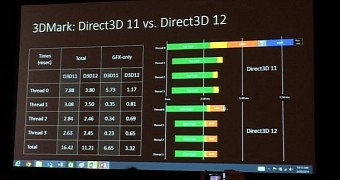Many people are talking and speculating about DirectX 12 and its magical powers to draw every little bit of juice from modern hardware platforms, and the potential of it improving video games performance by a large margin.
Microsoft's presentation at GDC 2015 certainly helped stir the buzz surrounding the upcoming DirectX generation, showing significant performance gains, with Xbox division boss Phil Spencer himself touting a 20 percent increase in GPU power.
One of the reasons DirectX 12 is such a hot button issue is the resolutiongate dispute, sparked by the fact that many recent titles did not manage to achieve platform parity on the Xbox One and PlayStation 4 home consoles.
As childish as it may be to compare games being 900p as opposed to 1080p on Microsoft's console to a legitimate public scandal about oppression and the abuse of power by those tasked with preventing exactly that, it's still an ongoing battle of attrition in the console wars.
What DirectX 12 will actually do
The underpinnings of the new API are nebulous to most gamers, so it's very helpful to see developers address this and explain it in terms that a laymen can comprehend.
Brad Wardell, the chief executive officer of Stardock Entertainment, posted a very interesting outline of how DirectX 12 works on his blog, revealing the differences between DirectX 11 and its upcoming successor.
The main thing that Microsoft's next API will do is enable proper multithreading, as currently DirectX 11 does all the CPU to GPU communication using one core. Sure, multiple cores are able to send jobs for the graphics card to perform, but the actual communication is still done one processor at a time, with the first core handling most of the load, as shown in various benchmarks so far.
DirectX 12 enables all your central processing unit cores to talk to the GPU simultaneously, and with modern graphical cards having a ton of cores, this means that developers can get a lot more out of the same hardware.
The results speak for themselves, and you can see the difference for yourself in the video below, showing Stardock's Nitrous Engine in action, on a system using DirectX 11 and on another one using DirectX 12. The difference is astounding.

 14 DAY TRIAL //
14 DAY TRIAL // 